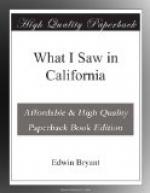“The edifices in some of those missions are more extensive than in others, but in form they are all nearly equal. They are all fabricated of mud-bricks, and the divisions are according to necessity. In all of them may be found commodious habitations for the ministers, storehouses to keep their goods in, proportional granaries, offices for soap-makers, weavers, blacksmiths, and large parterres, and horse and cattle pens, independent apartments for Indian youths of each sex, and all such offices as were necessary at the time of its institution. Contiguous to and communicating with the former is a church, forming a part of the edifices of each mission; they are all very proportionable, and are adorned with profusion.
“The Indians reside about two hundred yards distant from the above-mentioned edifice. This place is called the rancheria. Most of the missions are made up of very reduced quarters, built with mud-bricks, forming streets, while in others the Indians have been allowed to follow their primitive customs; their dwellings being a sort of huts, in a conical shape, which at the most do not exceed four yards in diameter, and the top of the cone may be elevated three yards. They are built of rough sticks, covered with bulrushes or grass, in such a manner as to completely protect the inhabitants from all the inclemencies of the weather. In my opinion, these rancherias are the most adequate to the natural uncleanliness of the Indians, as the families often renew them, burning the old ones, and immediately building others with the greatest facility. Opposite the rancherias, and near to the mission, is to be found a small garrison, with proportionate rooms, for a corporal and five soldiers with their families. This small garrison is quite sufficient to prevent any attempt of the Indians from taking effect, there having been some examples made, which causes the Indians to respect this small force. One of these pickets in a mission has a double object; besides keeping the Indians in subjection, they run post with a monthly correspondence, or with any extraordinaries that may be necessary for government.
“All the missions in this California are under the charge of religious men of the order of San Francisco. At the present time their number is twenty-seven, most of them of an advanced age. Each mission has one of these fathers for its administrator, and he holds absolute authority. The tilling of the ground, the gathering of the harvest, the slaughtering of cattle, the weaving, and everything that concerns the mission, is under the direction of the fathers, without any other person interfering in any way whatever, so that, if any one mission has the good fortune to be superintended by an industrious and discreet padre, the Indians disfrute in abundance all the real necessaries of life; at the same time the nakedness and misery of any one mission are a palpable proof of the inactivity of its director. The missions extend their possessions




